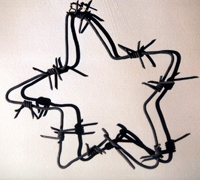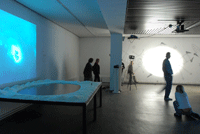
The Heavenly Forces of the Iron City (2007)
Exhibitions: Design of Siberia. Krasnoyarsk Museum Biennale, Krasnoyarsk Museum Center, Krasnoyarsk, 2007; Russian Dreams, Bass Museum Miami Beach, 2008; Unavoidable and Unnecessary, Moscow Museum of Modern Art, Moscow, 2008–2009
Barbed wire was invented by American farmers in 1874 as a cheap way of marking the borders of their pastures. The poundage of barbed wire produced annually soon reached six digits, and if someone could count the total amount manufactured since then, it would require astronomical units – enough barbed wire to build a fence from the Earth to the Sun. In the twentieth century, people, not livestock, were behind barbed wire for the most part – men of war, prisoners of war, prisoners, exiles, spies… But in any case, barbed wire was used to mark physical boundaries.
Zheleznogorsk is a city built by Gulag prisoners and guarded by special units from the Ministry of Defense. It manufactures weapons-grade plutonium and satellites. The satellites and the waste from their production are shut off from the rest of the world. With barbed wire, naturally. Sergey Shutov visited Zheleznogorsk as part of his artistic research, and then used barbed wire as a traditional artist would pen and ink. Using a material that triggers genetic fear in people and animals, Shutov has depicted the skyward-bound products of the closed city, its satellites and rockets, thus transposing earthly boundaries to the outer space. In Shutov’s context barbed wire is almost like a computer’s wireframe. He electrifies it – but with melodic ringtones rather than fatal voltage, making the wire virtually harmless and safe. It is a perfect example of artistic sabotage.
Yury Avvakumov



